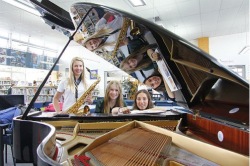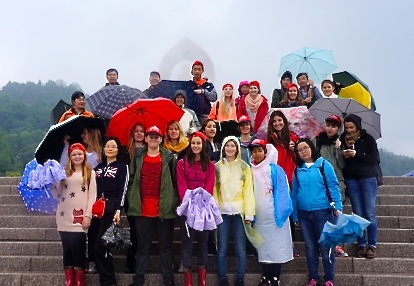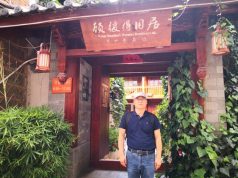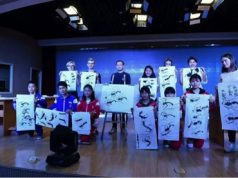
John Hodgson, President of Tauranga Branch of NZCFS, is thrilled to find that the four Bay of Plenty secondary-school arts students, who were chosen to go to China recently, have had such extraordinary success there. Chosen by a special subcommittee of NZCFS, Tauranga Opera Forum and a secondary school representative in February this year, they are part of the 2014 BOP Arts Scholarship programme.
Helena Jones, Simone Petero and Samara Somerville Petch, from Otumoetai College, Tauranga, and Taylor Asher-Law from Tauranga Girls’ College were recipients of the 2014 BOP Art Scholarship allowing them to attend the Middle School attached to Nanchang University (MSANU) in Nanchang, Jiangxi province. All costs in China were covered there, with the international flights being funded by the NZCFS Simon Deng Li Fund, for the four week visit during their April 2014 holiday. The group, multitalented within the arts, have, while in Jiangxi, endeavoured to get a Chinese perspective on their particular art, be it painting, photography, acting, performance piano, composition, conducting or singing – solo or choral.
At a concert at MSANU the students regaled their audience with Bach partitas, and other piano pieces. as well as Maori songs, The hour-long entertainment, which included some other items by visiting German and Chinese students, was very well received and in the audience were senior Government officials and Nanchang University’s Vice Chancellor. The Kiwis dressed well and performed professionally to a NZ backdrop using Powerpoint: Taylor sang Nga Iwi E, Samara sang ‘Let it go’, Helena played Bach’s prelude and fugue (both in A major) on the piano and Simone played the piano and sang the Geoff Buckley version of Leonard Cohen’s ‘Hallelujah’ after adjusting it musically for herself as she does with most songs: her hands quivered as though she were singing a Maori song.

During weekdays, the girls attended classes at MSANU including taking English, and they also re-established the English Corner at the school – blending well into the daily routine from 7.30am – 5.30pm. Between the weekday programme at the school and events organised by the host families at the weekends, the girls have had a wide range of Chinese cultural and social experiences. A highlight was the visit to the ancient Tengwan Pavilion but also they visited places outside of Nanchang, one visit taking in Jingdezhen, the porcelain capital of China, as well as Lushan Mountain. They have all been extremely busy: they and their host families becoming very close, so much so that maybe the girls were not looking forward to coming home, even “tearing up on Skype at the prospect”, said one of the mothers.
During the May Holiday break in China, host families took their New Zealand ‘daughters’ for final visits before they return to their studies in Tauranga. On the agenda was a trip to an ancient village, to the 12th Century Tengwan Pavilion (again), to the Star of Nanchang [Nanchang Eye], which until recently was the world’s highest ferris wheel, and shopping ad infinitum!
John is very pleased with this first exchange, which is expected to be reciprocated in due course with Nanchang students coming for a similar time to Tauranga. He has long held a desire to introduce young kiwis to China, for them to learn about that huge country, so very different from their own, and he feels that this is only the beginning of an opportunity to bring the two peoples of NZ and China closer together.
He says, “These young people have developed into capable, confident young ambassadors of tomorrow and we can feel justly proud of them.”
“I think that Simon Deng Li of the Simon Deng Li Fund, the delegation’s sponsor, can be justifiably pleased that we have put his money to such a good cause”.
Even as the students prepare to return from their sojourn in China, John has continued to work for more opportunities for students in both countries. He has already organized invitation letters for MSANU students to come to Tauranga. The Principal of Samar’s school, Otumoetai College is really supportive of further developments in exchanges and the Principal of Tauranga Girls College, has supported these exchanges since they were mooted several years ago. She has already invited MSANU students and teachers to Tauranga.
John also says that they are looking at organizing exchanges for teachers also, providing opportunities to develop their English. Tauranga Girls College principal is planning to visit China herself, so there will hopefully be further opportunities for young people and teachers. John is also a great advocate of the students staying with families, which gives them a far greater understanding of people of a different country.
This is proved by the success Samara had with her home stay family. She went out with the family for exercise, joined a singing group with them, cooked with them and also took English lessons. John finds this aspect especially satisfying. On Simone’s behalf, he asked that she receive help from OuYang, an artist who promised to donate high-resolution photos of some of his works to sell to help raise money for their trip. Surely a kind thought from our Chinese friends. John states that each of the Arts Scholarship students have their own particular abilities and received every opportunity to get that all-important Chinese perspective of their own art.
And a final farewell…..
The leader of the welcoming group, Li Ping, wrote a final farewell to the group and in particular to Simone with whom she attended an art exhibition before the students made their final leaving preparations. See the box below for what Li Ping said about the venture….
I just came back from an art exhibition with Simone and Ou yang’s wife—Wejun Huang. Simone’s class will hold a farewell party for her. So will the other New Zealand students’ classes. It is the time to say goodbye, but it is really not easy for every one to do so, I’m even afraid to see the scene. This morning, 6 New Zealand students went to the headmaster’s office to say goodbye to Headmaster Huang, they are welcome to come to our school again. Headmaster Huang said they can consider our school as their own mother school. We are all happy and moved to hear this, our friendship will go on and go on……
We have to say goodbye, since there is no never-ending feast. However we expect the day to meet again, what we can do in the future days is to help more students and teachers to exchange , it is a great future, isn’t it ?
We will set off at 6 tomorrow morning to the airport ! What about the other end, you are surely eager to welcome them back, so, ready at Auckland, they are coming !
Best regards!
Li Ping
“And we do hope this is not the end but the beginning of many new exchanges between the young people of Jiangxi and of the Bay of Plenty”, suggested John.
Teri France, May 2014
Postscript
Vote of thanks from the students
At a meeting of Tauranga Branch (October 2014), all four Tauranga students who “took the journey of a lifetime” to Nanchang in China, as part of the NZCFS Arts Scholarship this year (see above), expressed their thanks to all those who had made their trip possible . Each of the girls shared their art, and each spoke about their experience living in Nanchang, meeting many new people and seeing things they never imagined: the meat and vegetable markets, the traffic behaviour, the crowds, the shopping, everything so different – and they loved it all.
The students shared their arts that they did in Nanchang. Samara and a friend sang the ‘Flower Duet’ from Lachme, Taylor sang ‘E iwi e’, Helena spoke about the portfolio of miniatures that she painted in the streets and countryside of Jiangxi, and Simone had everyone in laughter at her recollections of life in Nanchang. Together the girls sang “Moli hua”.
Later each girl also wrote of their experiences and how they coped with life in China during their stay. They, without exception, wrote of their host families in glowing terms, describing how the families went out of their way to make them welcome. As a result they have made long-term friends and have promised to return if and when they can, as well as saying that they would be happy to host in return. Most likely this will happen early in the new year when the students are still on holiday and can share New Zealand with the Nanchang students.
The advances they made in learning their special subjects (in particular calligraphy and Chinese painting) were, by their account, phenomenal and they appreciate that such learning would have been impossible in New Zealand. Here are some of their comments:
Taylor Asher-Law (from Tauranga Girls College):
“In one of the speciality classes offered and hosted by ‘our’ school, we learned calligraphy from advanced traditional calligraphers living in Nanchang. None of us thought it would be as difficult as it turned out to be, with the order of the brush strokes confusing to each of us. However, we are all really pleased with our artwork and enjoy knowing the hard work that went into it.”
Simone Petero (from Otumoetai College, Tauranga):
“One of the reasons I applied for this scholarship was so I could experience different methods and techniques within art. After joining my host father’s art classes during the weekends and experiencing art lessons within the school, I realised that their methods of teaching art and their techniques are quite different to what we have in our schools. Here in New Zealand… well in my school anyway, teachers tend to focus more on expanding on the student’s imagination and creative capabilities when it comes to conveying messages and stories. But in the art classes in Nanchang, I noticed the teachers demonstrating and helping the students to perfect a certain sketching technique known as cross hatching. As I was sketching a portrait of Chinese leader, Mao Zedong, my host father advised me to see the portrait as a whole rather than paying attention to one aspect at a time. This advice has helped me back in New Zealand and will stay with me hopefully forever as I develop my own styles and techniques. On the more traditional side of things, the group of us had the privilege of testing our skills with ink on rice paper. There was a lot more technique in practising this method of art than I had anticipated. The brush had to be vertical when in use. You had to watch that you didn’t get too much or not enough ink and watch that you didn’t get too much or not enough water on your brush. Even holding the brush in a particular way.
Helena Jones (from Otumoetai College, Tauranga):
“The speciality classes held by the school, which included Chinese calligraphy and traditional painting, were super interesting and very informative. Our teachers were top in their fields and able to share their extensive knowledge on the history of the materials and techniques used. For Chinese painting there are four components: the brush, which is wolf hair for toughness or sheep hair if you would like soft; rice paper and ink made from the ash of burnt trees and finally the special stone for the ink to sit in. To be able to listen to how the making of the materials has progressed, as well as how the calligraphy brush strokes developed over time, was a real privilege. Here in New Zealand we don’t have easy to access to the depth of history and tradition they have, and so to get a glimpse was wonderful and not something I will forget.
Thank you for this amazing opportunity, it has changed my life and I am so grateful :)
Samara Somerville Petch (from Otumoetai College, Tauranga):
“On the fifth floor of the school was the art room where leading artists in each of their fields taught us ancient art such as painting and calligraphy. It was amazing seeing them in their element and it made me realise the amount of time and effort it takes to perfect your art. Although it looks easy from the outside, when you actually try to emulate what you have just seen, it’s a completely different story. It takes precision and patience to get each stroke pattern right and I feel that Chinese art is not just about painting or words, but also about the hidden meaning behind it.
“When going over to China, I would be the first to say that to become a successful choral director, research is of the utmost importance and, of course, the more international the better. The difference in China is in notation, as the Chinese work from the do-re-mi system closely with x’s and lines to indicate the rhythm. It was interesting to see the way that they interpreted the music and that it was mainly based on scale degrees. Although it was a different notation to what I’m used to, one very easily got into the rhythm of interpreting it.
“I am eternally grateful and am excited to see how this programme will evolve for the next students to have this opportunity next year.”
All four girls confirmed that the trip has changed their view on Chinese life and will affect their attitude to other people of other cultures.
Teri France, October 2014




